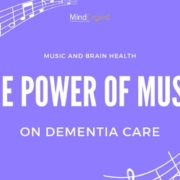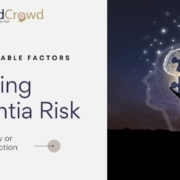Neuroplasticity of the Brain & Physical Exercise: Keeping a Sharp Mind
Curious as to how exercise can increase neuroplasticity of the brain? Joyce Gomes-Osman, PT, PhD shares the latest research on a sure-fire way to revert brain aging.
Neuroplasticity is the ability of the brain to develop new neural pathways or connections between brain cells or neurons. Most neurodegenerative diseases such as Alzheimer’s or Parkinson’s as well as mild cognitive impairment, are accompanied by a loss of brain plasticity.
Increasing neuroplasticity could help us avoid the loss of cognitive skills, such as learning, remembering and decision-making, as we age. Exercise is vital for keeping our brains sharp as we grow older, and hurricanes can help us understand why.
Read on to discover the latest research recommendations to keep or improve neuroplasticity of the brain and fight cognitive decline. Revert brain aging by keeping a sharp mind!

Why is Brain Plasticity or Neuroplasticity important to your Brain?
If you have witnessed at least a handful of hurricanes in your life, you may have noticed that we typically see many trees and shrubs on the ground when we come out of our homes after a storm. My question to you is: Which tree is usually best at weathering storms? Most importantly, why?
The first part of the answer is easy: It is the palm tree! For the second part of the answer, many of us may think that palm trees do so well because they have very deep roots, but that is not true. The real reason why palm trees weather storms very well is that they are flexible; and thus,’go with the flow,’literally!
A similar situation happens with our brains as we age. Scientific studies show that flexibility is also a critical characteristic of human brains that should be trained to keep as we go through life, and becomes even more critical for older adults.
This flexibility allows our brains to undergo enormous changes in response to our experiences. As a result, our brains continuously adapt and learn. Whether it is algebra, getting around in a new city, or taking care of a loved one, you need a flexible brain in order to learn.
This flexibility of the brain is called neuroplasticity or brain plasticity (as the figure suggests, the brain is flexible, moldable even!).

Scientific studies show that neural plasticity decreases as we age, and this goes together with the challenging parts of aging, such as trouble with thinking abilities.
Can Exercise Help Increase Neuroplasticity and Revert Brain Aging?
Exercise is most effective than any therapy that currently exists to maintain and improve cognitive brain health.
The good news is that research performed over the last 20-30 years, including work done in our lab, shows that regular exercise can increase neuroplasticity of certain structures of the brain. Consequently, exercise can help us maintain and even improve our thinking skills as we age.
These studies show that regular physical exercise can promote a healthy, sharp brain in two essential ways:
- exercise leads to faster processing of mental tasks
- exercise leads to better problem-solving skills
These results are very encouraging because problems with the speed of processing and problem solving are often the earliest signs of age-related decline in thinking abilities. In other words, this research suggests that it is possible to turn back the clock of aging in the brain by adopting an active lifestyle.
What can I Do Today to Develop New Neural Pathways?
Today, I can give you three main pieces of practical advice to guide you in incorporating exercise for your brain health (and this is based on an analysis of nearly 100 exercise scientific studies).
1. What Type of Exercise Is Best for the Brain?
Scientific evidence supports that many different types of exercise can contribute to improved thinking abilities. Most of this evidence comes from aerobic exercise – such as walking, running, and cycling -, but also weight-lifting and mind-body exercises – like yoga and tai-chi – can contribute to improved thinking abilities.
It is very encouraging that the evidence supports all sorts of different exercise interventions (not just aerobic) to improve brain plasticity. Some sedentary people may need to start with a more gentle routine, eventually building up to more vigorous exercise practices.
In addition, many people already engage in resistance training for other reasons, such as building stronger muscles and bones.
On this note, if you are sedentary and thinking of starting to exercise, consult your physician or physical therapist to help you get a safe start.

2. How much Exercise is Needed for Brain Health?
How much exercise and what types of exercise are good for the adult brain is the multimillion-dollar question we are trying to answer through research. But having said that, we don’t believe that the solution is likely to involve a one-size-fits-all approach.
When we study treatments for other diseases, such as high blood pressure, we know each patient receives a specific dose of blood pressure medication. The medication dose that works for dad is likely not to going to work for a cousin or an aunt.
As such, the ‘best’ exercise regimen to promote brain health for you might be very different from your cousin’s or your aunt’s regimen.
You can imagine how busy we are in the lab working on studies that can help us shed light on these questions! Our goal is to better understand effects of exercise on areas of the brain and to do this we are even using neuroplasticity tests.
The total amount of hours spent exercising as part of an intervention seems to be particularly relevant for the cognitive effects of exercise on the brain.
Our analyses suggested that most significant gains began to occur after about cumulative 50 hours of exercise (over about 4-6 months). That is an average of 2 to 3 hours every week for 4-6 months.
But more long term benefits are likely possible as one keeps going.
Be part of the solution. Help scientists understand how to prevent dementia. Take the MindCrowd test today 👉 mindcrowd.org
MindCrowd is a scientific study that gives researchers a set of data baselines about how normal, healthy brains perform at different ages.
MindCrowd cannot diagnose dementia or predict the risk for cognitive decline. By taking this quiz you will help researchers in the future to more properly evaluate Alzheimer’s patients and usher in a new era of precision aging.
Test your brain 👉 mindcrowd.org 🙏
3. Change or Develop New Habits
Adherence (a.k.a., actually showing up) was found to be a major challenge. Changing our behavior and habits can be hard. So, learning more about yourself and figuring out how to keep yourself motivated is very important.
Also, slip-ups are a part of the journey. Having back-up plans for when you feel tired or can’t do what you had planned is also necessary (how will you exercise when that storm does come and you can’t go for your outside walk?).
While hard, making new habits is certainly possible and within reach! Planning is crucial. Start by coming up with some exercise goals. But don’t choose something vague like, “I will walk tomorrow.”
Goals have to be SMART. What do I mean by this?
S = Specific (not just “exercise,” what will you do specifically?)
M = Measurable (how much, how often, and for how long?)
A = Attainable (is it feasible to exercise every day if you have not exercised at all last month?)
R = Relevant (you will be most successful if you feel that this is important to you)
T = Time-Bound (how long do you plan to stick to this plan?)
Here’s an example: “During the next month, I will walk four days every week for 30 minutes each day.”
Who’s ready to begin a new, more active chapter in their lives?
FIND OUT MORE ABOUT YOUR BRAIN.
Discover how it compares with others like you in 10 short minutes by playing the free online MindCrowd memory game.
And help scientists find new ways to protect our brains from memory loss as we age.
Stay Tuned for News about Brain Aging and How to Avoid Cognitive Decline.
Dr. Joyce Gomes-Osman, P.T., Ph.D. is a rehabilitation neuroscientist with a Ph.D. from the University of Miami Miller School of Medicine, and a postdoctoral fellowship from Harvard Medical School. She is an Assistant Professor of the Departments of Physical Therapy and Neurology at the University of Miami Miller School of Medicine and maintains her affiliation with the Berenson-Allen Center for Non-Invasive Brain Stimulation at Beth Israel Deaconess Medical Center, Harvard Medical School. Dr. Gomes-Osman is also a KL2 scholar from the Clinical and Translational Science Institute at UM. She divides her time between working in the Laboratory, and teaching neurophysiology and non-invasive brain stimulation.









Thank you for all of this information! I appreciate it!